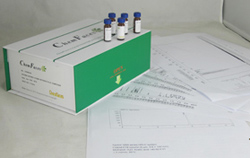Hot Products



| Catalog No. | Information |
| CFN89145 | Eriobofuran Eriobofuran, a phytoalexin, has antimicrobialactivity, it can inhibit strongly the spore germination and germ tube growth of Pestalotia funerea, a host-pathogenic fungus of loquat tree. |
| CFN97402 | Eriocalyxin B Eriocalyxin B induces apoptosis and cell cycle arrest in pancreatic adenocarcinoma cells through caspase- and p53-dependent pathways, should be considered a candidate for pancreatic cancer treatment; it is a specific inhibitor of STAT3, it directly targets STAT3 through a covalent linkage to inhibit the phosphorylation and activation of STAT3 and induces apoptosis of STAT3-dependent tumor cells. Eriocalyxin B exerts potent antiinflammatory effects through selective modulation of pathogenic Th1 and Th17 cells by targeting critical signaling pathways. Eriocalyxin B reversibly interfer with the binding of p65 and p50 subunits to the DNA in a noncompetitive manner. |
| CFN99718 | Eriocitrin Eriocitrin is powerful antioxidative flavonoid, it can prevent oxidative damages caused by acute exercise-induced oxidative stress, it also has lipid-lowering effect in rats on a high-fat and high-cholesterol diet. Eriocitrin is a potent inhibitor of human carbonic anhydrase VA isozyme. |
| CFN99719 | Eriodictyol Eriodictyol has vasodilator, anti-inflammatory and antioxidant activities, it is an antagonist of the transient potential vanilloid 1 receptor (TRPV1) receptor. Eriodictyol may possess antidiabetic properties through increasing glucose uptake and improving insulin resistance, it attenuates the degree of retinal inflammation and plasma lipid peroxidation preserving the blood-retinal barrier (BRB) in early diabetic rats. It may be a potential therapeutic resource for Atopic dermatitis and an adjunctive agent to control itchiness inAtopic dermatitis. |
| CFN95290 | Eriodictyol 7-O-glucuronide Eriodictyol 7-O-glucuronide can be considered as potent inhibitors for DENV NS2B/NS3pro for the development of anti-dengue drugs. Antioxidants.Cytotoxic. |
| CFN94150 | Eriodictyol chalcone Eriodictyol chalcone has anti-plasmodial effects on P. falciparum growth. |
| CFN91945 | Eriodictyol-6-glucoside (S)-Eriodictyol-6-C-glucoside and (R)-eriodictyol-6-C-glucoside could be antioxidant markers. |
| CFN97865 | Eriodictyol-7-O-glucoside Eriodictyol-7-O-glucoside and epicatechin appears to be responsible for the antioxidant activity of pistachio skin.Eriodictyol-7-O-glucoside has protective effect on cisplatin-induced toxicity was investigated in a human renal mesangial cell line, HRMC; it also can activate Nrf2/ARE signaling, directly associated with its neuroprotection against oxidative stress-induced ischemic; suggests that targeting the Nrf2/ARE pathway may be a promising approach for therapeutic intervention in stroke. |
| CFN98050 | Ermanin Ermanin shows anti-inflammatory activity by suppressing the iNOS and COX-2 expression. Ermanin may have anti-HIV-1activity. Ermanin also has a high deterrent activity at 40 ppm against Dione juno larvae. |
| CFN00453 | Erucifolin N-oxide |